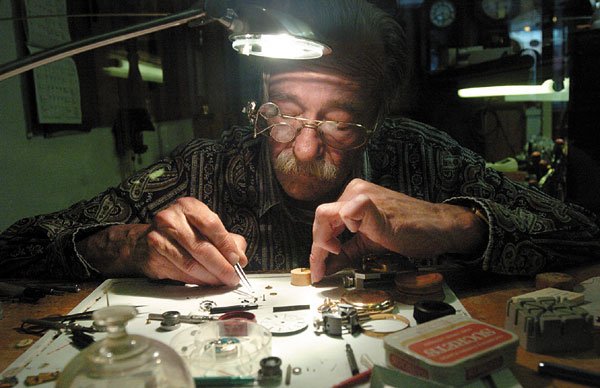Two grizzled old men work quietly, save for the steady ticking
of timepieces and a crackling radio playing country songs.
BY Perry Shirley staff writer
Gilroy – Two grizzled old men work quietly, save for the steady ticking of timepieces and a crackling radio playing country songs. Larry DeMoss, 68, with his boots and graying ponytail takes care of the front end and is fond of working on clocks, while Randy Swartz, 56, speaks little, preferring the minutiae and individuality of watches.
Together they fix, sell and barter timepieces out of Clock and Collectibles, a small downtown shop on Monterey Street off Lewis Street that is often overlooked but practicing a trade that is essential because it’s so specialized.
“There’s always a need for this type of job,” DeMoss said. “Randy says there’s only two ways to get out of this business: die or go blind.” In fact, they said they recently lost two watchmaker friends, one to death, one to blindness.
The shop’s facade is unassuming, pink with a simple white and red sign. Inside, large display cases are filled with valuable old watches, pricey luxury brands and very few quartz models. The real toiling takes place farther back behind glass panels on beat-up old desks. Though there are easily hundreds of watches, few tick and chime – together, they would make an unbearable clatter, they say, and winding them takes time, time away from work.
DeMoss and Swartz spend between 40 and 70 hours a week here, working on eight to 10 timepieces at one time, slightly fewer watches than clocks. Much like doctors, they sometime make house calls to repair grandfather clocks too fragile or cumbersome to move.
Because the theory of clock operation is fairly simple and has changed remarkably little over the centuries, repairing watches is basic enough, requiring good eyes, steady hands and a “little bit of concentration,” DeMoss said. Because they often deal in units measured in one-hundredths of a millimeter, microscopes, loupes, magnifying glasses and infinitesimally small tools are necessary.
All too often, though, the shop will inherit timepieces that have been taken apart by overzealous hobbyists, bringing in a jumble of pieces in a bag.
“It takes the ability to put something back together you took apart,” Swartz said, “and sometimes things other people took apart.”
After a half-century of working on timepieces, DeMoss said he feels an almost human kinship with them. He said he has seen patrons come back time and time again with clocks that inexplicably stopped working properly in their owner’s home – but worked like a charm at the shop – and swears some clocks don’t like their owners.
“Whether it’s a watch or a clock, it has its own personality, just like people,” DeMoss said. “We’ll talk to it, we’re nice to it. We have sympathy for the clocks but none for the owners.”
While most fixes are simple enough, the pair recalled a patron who came in with a pocket watch dating back to 1789 that provided something of a challenge and a thrill for DeMoss and Swartz. When told the cost and that it would take a year and a half to hand-manufacture components and put the piece back together, the customer balked.
“We can always find a way to fix it,” DeMoss said. “It just takes time and money and some people don’t want to pay the money.”
They ended up buying the watch, fixing it after some trial and error and selling the piece within months of putting it on display.
Still, something keeps watch owners and collectors coming. DeMoss began his business about 20 years ago, working out of a small booth inside a Gilroy antique shop and repairing watches out of his garage shop. One day, Swartz walked in with his 20 years of experience repairing anything and everything mechanical on ships in the U.S. Navy Seaman Corps. He showed he could easily work on watches and was hired on the spot. A year later, they moved into the current location.
Gilroy resident Paul Rodriguez, 51, came by the shop Wednesday to add to his collection of watches, as he has for the past six years. “I like going to a local business instead of going to the big boxes like Best Buy,” he said. “In this day of no personal connectedness, it’s nice to come to a place where they recognize you.”
Two kinds of people usually come in to the shop: those looking for repairs and collectors. DeMoss feels a certain kinship with the later, having amassed more than 40 clocks are in his home since he began collecting them in his childhood, while Swartz said he enjoys “working on them more than having them.”
Today, their hands are steady, though rough and worn. Their eyes are sharp, though aided by glasses and magnifying devices. Most of all, their knowledge of clocks and watches is broad and their passion for the work is strong.
It seems as though it will take death or blindness to tear DeMoss and Swartz away from their shop.
“I don’t know if I ever will retire,” Swartz said. “Once you get into this business you don’t want to get out of it.”













